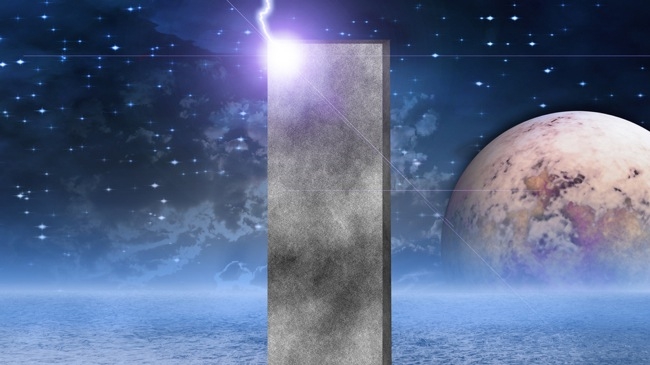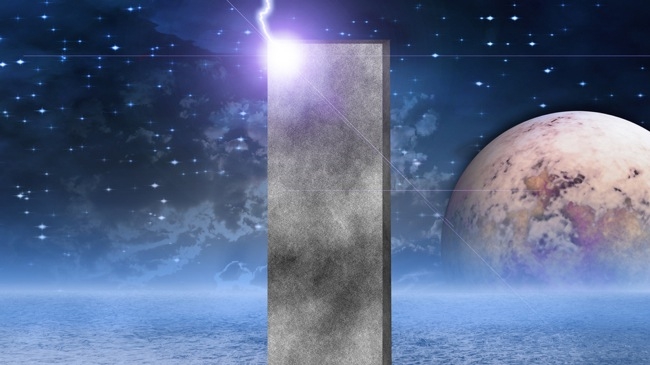
 History of VFX
History of VFX
From World War II to the 1980s, the model men and the optical effects units held sway in the world of movie VFX. Computers were on the way, but first the world's effects teams had to deal with the little problem of colour. By Andy Stout.
Part one is here
At the end of the Second World War Michael Powell and Emeric Pressburger were commissioned to produce a film cementing American and British relations. What they came up with instead was A Matter of Life and Death (1946), a searching examination of American and British relationships couched in a film where a British pilot fights for his life in front of a heavenly court, and also one of the finest films to come out of the period. With sumptuous cinematography from the legendary Jack Cardiff, some of its effect sequences have passed into legend – notably the infinite staircase ascending up to Heaven. Its use of colour was also revolutionary, switching between Technicolor for its real-world sequences and back to monochrome for anything occurring in the celestial realm.
The effects technicians of the day would also like to have switched back to monochrome, because incorporating the new technology into the existing and hard learned effects techniques was not an easy task. Slow film stocks meant that colour had to be shot under intensely bright light, which initially at least tended to wash out rear projection screens. Travelling matte techniques needed to be adapted to, while matte painting itself had to almost completely change. Where once only greyscale tones had to match, now every colour and shade had to match up with the original footage, which given the stability of the stocks at the time was something of a challenge. Gone with the Wind (1939) was probably the first film to display the evolved techniques that were developed to adapt to colour to the best effect.
Model warfare
In the main though with a wartime economy and the movie industry pressed into the propaganda effort, most films of the 40s remains in black and white (indeed, the movie industry didn't switch to colour wholesale until the 1960s when it could sell colour films on to colour broadcasters). At the same time, an increasingly sophisticated army of modelling techniques serving to recreate European and Pacific battlefields for the silver screen; naval fleets engaged in giant studio water tanks, while squadrons of fighter planes flew by wire in front of the cameras.
Fast forward to the 50s and probably one of the major changes was just that instead of making models of battleships, model makers were making models of spaceships for the era's burgeoning science fiction films. One of them was also about to become a star in his own right too, Ray Harryhausen inventing a genre and style of creature feature all by himself that has persisted to this day. Beyond the stop motion animation techniques synonymous with his name, the features also used a variety of techniques to achieve their effects, The Seventh Voyage of Sinbad (1959), for instance, using everything from perspective tricks to split screen mattes and differently sized props to achieve its effects.
Innovation continues
That said there were technical innovations in the effects field, notably a new travelling matte system that used sodium vapour lighting, as well as the development of the first crude motion control systems. The former was one of the number of techniques that used differently lit backdrops to achieve the same goal and resulted in the most accurate mattes produced yet. It also allowed for the photography of transparent objects such as liquids, and can be seen at work in films of the time such as Mary Poppins (1964) and The Birds (1963 - which also featured some phenomenally intensive hand-rotoscoping efforts to assemble some of the avian-populated shots). Motion control techniques of the time, meanwhile, included recording pan and tilt motion with a needle onto a old-school vinyl record which could then be played back to drive equipment and replicate the original movements.
Hollywood, however, hit the1960s engaged in an arms race where the size of casts and the size and costs of sets were seen as important components in the marketing warfare. This was an era of practical effects rather than special ones, of boasting of a cast of thousands and crashing real planes and real cars and filming the effects, rather than trying to recreate it all in miniature or in camera. Even films such as Fantastic Voyage (1966) used immense sets and a full-sized submarine to recreate its supposedly miniaturised scenes.
Waltzing spaceships
One film changed all that though and can be justifiably called the most important film in the history of VFX. Based on a short story by Arthur C Clarke, 2001: A Space Odyssey made Stanley Kubrick's career and effectively rewrote the future - certainly for a small group of effects technicians working on the film in England, one of whom, Douglas Trumble, went on to become one of the leading visionaries in late 20th-century effects work.
Its major innovation lay in its adroit use of front projection, which is used throughout the film from the opening 'Dawn of Man' sequence onwards. Essentially it works by mounting a camera and projector at 90° to each other, while placed at 45° between them is a beam splitting mirror that is 50% reflective. A projector throws the 50% reduced background image via the mirror to a highly-reflective screen behind the actors. This boosts the light again and directs the background image back once more through the mirror and directly into the lens, whereas light hitting any foreground people or objects is refracted all over the place and effectually becomes invisible when the set is lit correctly. The foreground objects all cover their own shadows and the result is a perfectly combined image that can be shot in a much smaller space, much more quickly than rear projection techniques.
Far more accurate motion control was developed to photograph the films enormous model spaceships – the reason they have such a sense of scale is that on film is that some of them were approaching 18m long — while for the famous Stargate sequence a wholly new technique called slit scan animation was developed which, simply put, exposes one frame of film over a long period of time to moving artwork filmed through a slit. The world's hippies were suitably appreciative.
The computer graphics elements seen on the spaceship scopes in the film were, of course, hand drawn, there being no computers powerful enough to throw such visual objects around at the tail end of the 1960s.
They were coming, but not just yet.
1977 and all that
The 70s saw a turn to fairly big budget disaster movies and more of the miniature work that Hollywood had specialised in before. Then, of course, we get to 1977 and two directors, George Lucas and Stephen Spielberg, changed the rules of engagement entirely.
Star Wars: Episode IV, A New Hope required Lucas to set up his own effects shop, the now famous Industrial Light & Magic, to achieve the sheer range of effect shots in the film. All the techniques of the time— matte paintings, animation, stop motion, make-up – were pushed to their maximum, while some, such as computerised motion control, were developed specifically to film the many blue screen model shots with realistic motion blur.
It won ILM the Oscar, but arguably Spielberg's effort, Close Encounters of the Third Kind, was a superior technical achievement. With Douglas Trumbull helming the effects effort, as with 2001 the film used front projection again, forced perspective models, motion control, cloud tanks and models cunningly filmed in smoky atmospheres to impart scale, all combined with filming on immense sound stages.
Interestingly, Spielberg was also one of the few directors of the time who thought about using computer generated images for elements of the closing scenes. The concept never made it past the pre-production stages, but is noticeable for being more forward-thinking than the simple vector graphics sequences that were used to depict, er, computer graphics elsewhere in the industry at the time.
Both films represent the start of the end of an era. They showcase exactly what can be done without computers (and, of course, Lucas's re-release of the CG-enhanced Episode IV 22 years later in 1999 showed that use of digital techniques was not necessarily going to result in superior filmmaking). They took techniques that had mainly been developed over the previous decades and pushed them to their limits. That they still look great to this day is a testament to the skill and knowledge of the technicians who worked on them, but around the corner, someone was firing up a Lightcycle...TRON was on its way.
Part 3 of The History of VFX is here
Tags: Technology


Comments